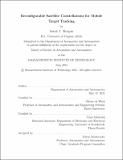Reconfigurable Satellite Constellations for Mobile Target Tracking
Author(s)
Morgan, Sarah J.
DownloadThesis PDF (8.926Mb)
Advisor
de Weck, Olivier
Terms of use
Metadata
Show full item recordAbstract
Current storm monitoring satellites offer unsatisfactory coverage of ongoing storms, either obtaining low spatial resolution, persistent coverage or high spatial resolution coverage with low temporal sampling. A reconfigurable constellation of satellites (ReCon) offers a way to augment these data sources with higher resolution coverage and improved temporal sampling. A ReCon can respond dynamically to different objectives throughout its mission lifetime, offering a more responsive, adaptable alternative to traditional Earth-observing satellite constellations. In the ReCon concept of operations, the constellation is nominally positioned to obtain global coverage. If an event of interest occurs at a particular latitude and longitude location, satellites can be maneuvered to obtain more frequent accesses of this target than otherwise achieved in the nominal configuration. While this architecture has been primarily explored with static ground targets in mind, for more dynamic events of interest, such as hurricanes, an additional layer of responsiveness can be added. A method of mobile target tracking through planning a series of low-thrust maneuvers holds promise. This method has been shown to improve the coverage characteristics of a single satellite in a hurricane case study when compared to a non-maneuvering satellite. This thesis explores and expands upon this concept, reviewing the existing work and applying an alternative approach. Throughout this thesis, procedures for adaptive reconfigurable maneuver planning are laid out and used for two hurricane case studies. This more flexible approach finds solutions for a single satellite case study observing Typhoon Megi using around 2 m/s delta-V, in comparison to similarly performing solutions previously found of around 13.5 m/s delta-V. The inclusion of an optimizer in maneuver planning enhances the prior work, exploring a continuous design space of possible maneuver options. This reveals alternative solutions and a more complete view of the entire design space. This optimization approach also allows a future user to explore the objectives of increased storm access time, closer flyovers, and total delta-V cost of maneuvers. For example, in a single satellite maneuvering case, total target access time can be doubled in comparison to a non-maneuvering case with the use of only around 2.5 m/s delta-V. Overall, this approach has resulted in the exploration of key tradeoffs between these objectives. For example, increased access time or closer passes each come at the cost of increased delta-V requirements; solutions that provide the same total access time require greater delta-V to achieve closer passes and vice versa. When considering the inclusion of multiple maneuvering satellites, diminishing returns of maneuverability are observed, with greater natural accesses occurring with a greater number of satellites in the constellation. Additionally, the concept of executing this method in real time with uncertain targets based upon hurricane forecasts is explored. This reveals the need to incorporate robustness into this optimization. Finally, the prospect of executing this theoretical concept with a ReCon demonstrator is evaluated, including taking into account potential errors in maneuver planning.
Date issued
2021-06Department
Massachusetts Institute of Technology. Department of Aeronautics and AstronauticsPublisher
Massachusetts Institute of Technology